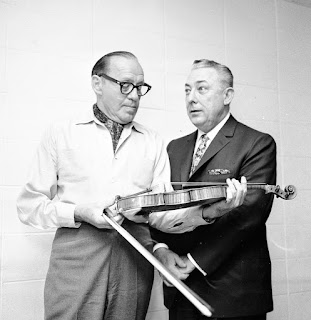I love Leon Schlesinger.
Yeah, he may have been a little boorish and tacky, but he seemed to have a sense of humour about himself, hung out bowling with his staff and, best of all, hired some great cartoon directors and (for the most part) only demanded they make funny cartoons for the amount of money Warner Bros. was providing.
You may know a little bit about Leon’s background. Before hiring Hugh Harman and Rudy Ising in 1930 to make cartoons for him, he was the head of Pacific Art and Title in Hollywood. Prior to that, he had worked in theatres in Philadelphia (Arch, 1906) and Chicago (Colonial, 1907), where he married Ray Katz’ sister in 1909 (Katz later managed for him at the cartoon studio).
But something I didn’t know about Schlesinger was his career in Canada. I’ve never seen it in any biographical material, but spotted a reference to it in
Boxoffice magazine of April 8, 1963, years after Schlesinger’s death. In a story about the opening of a new Odeon theatre in Vancouver, there’s a reference to a man who had owned a long-departed theatre called the Globe, which opened in 1913. The story adds:
The Globe was managed by Leon Schlesinger, who later went to Hollywood and gained a measure of fame producing Porky (Thh-aa-tss All Folks) Pig cartoons.
Could it be true?
I dug around in some copies of various publications. Aha!
Motion Picture News of February 27, 1917, wrote about Schlesinger’s latest venture, a new kind of movie screen. It stated:
Starting with the old Charles E. Blaney forces, in Philadelphia, Mr. Schlesinger followed the old-line theatrical business for a number of years before entering the motion picture field as an exhibitor. Because of his activities in and around Chicago, throughout the Middle West, in Canada, from the Atlantic to the Pacific Coast, and in and around New York City, Mr. Schlesinger is known to scores of exhibitors who are now purchasers of Radium Gold Fibre screens and whom he is able to approach as a friend of long standing.
So, yes, it was true.
Contemporary publications revealed he was managing the Orpheum in Jersey City in January 1913 and the Central Opera House in New York City in February 1913.
The Grand Opening of the Globe was Wednesday, March 19, 1913. Few of Vancouver’s old newspapers are available to search on-line and OCR errors make the situation worse. But there’s one interesting little piece I spotted in the Vancouver
World of November 18, 1913:
Crackers Nearly Succeeded
An unsuccessful attempt is said to have been made to rob the safe of the Globe Theatre, situated at 851 Granville street on Saturday night. It is not known how entrance was gained, but it is thought that the would-be burglars paid the admission fee and concealed themselves in the theatre until the house was closed for the night. The outer door of the safe was found open in the morning by Mr. Leon Schlesinger, manager of the theatre, and the inner door partly drilled. It is thought that the safecrackers were frightened away when their task was nearly completed. There was $50 in the safe. The manager's desk was broken into and $1.60 stolen. The police are making investigations.
He can be found in the Vancouver City Directory for 1914 (meaning listings were compiled in 1913) . It gave his work address as 845 Granville and that he lived in the Grosvenor Hotel at 840 Howe Street, a block from Theatre Row (in thinking about it, the Grosvenor and the theatre would have shared the same back lane).
Leon was gone from Vancouver in 1914. It would appear he crossed Canada as the Toronto
Daily Star of the day revealed he was managing the Strand theatre there.
Moving Picture World reported on August 7, 1915, he had been hired to manage the Palace theatre in Buffalo. So ended Leon Schlesinger’s Canadian sojourn. In 1917, he was sales manager for Inter-Ocean Film in New York City, and in 1920 was managing the Joe Miles Film Service Bureau. It was in that capacity that Schlesinger worked out a deal in May 1921 to acquire negatives of the films of Georges Méliès, which were donated to the Academy of Motion Picture Arts and Sciences after his death on December 25, 1949.
I wish I could tell you more but, th-th-that’s ... oh, you know the line.


















































